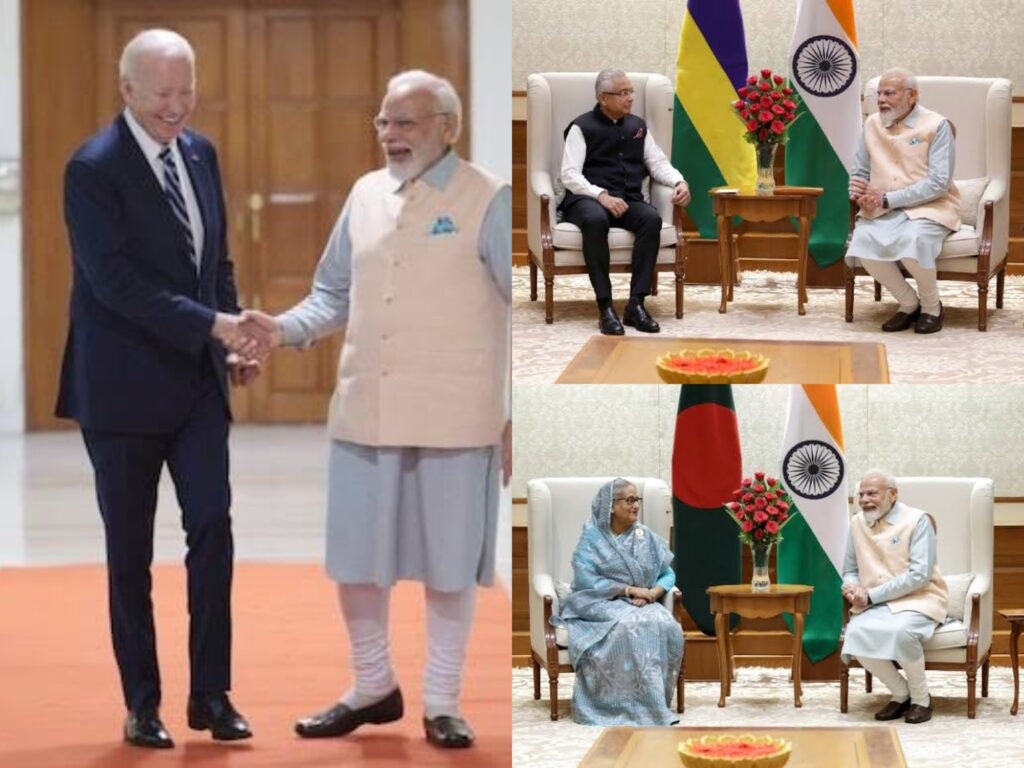
As India welcomes the leaders of the G20 summit, it’s important to note the kind of engagement it engaged in before the summit in Delhi. India has planned 15 bilateral meetings during these 3 days which includes important discussions on pertinent issues of our time.
The Indo-ASEAN summit that took place in Jakarta, Indonesia on the 7th of September is a very important event to be noted. Prime Minister Narendra Modi not only decided to open a consulate in Dili, Timor but showed support for the centrality of ASEAN in the Indo-Pacific. A 12-point proposal to enhance Indo-ASEAN ties was shared by the Indian delegation. (The points are available on the MEA website) The basis was to enhance engagement with ASEAN on a priority level.
On the 8th of September, India kick-started its engagements before the summit starting on the 9th. Three countries were scheduled to meet before the G20 summit. As world leaders, business leaders and heads of important organisations arrived, India met the heads of state of Mauritius, Bangladesh and the United States of America.
INDIA- MAURITIUS MEET
Prime Minister Narendra Modi held talks with Mauritian counterpart Pravind Jugnauth. Marking 75 years of diplomatic ties between them, India reiterated its commitment to increase the voice and the weight of the global south. The Prime Minister tweeted that discussions around cooperation in sectors like infrastructure, FinTech, Culture and other areas. The Mauritian Prime Minister shall be attending the G20 summit as well.
It’s important to note that Mauritius has had a considerable Indian ethnic population since colonial times that plays a key role in the African policy on India. Many India-assisted development projects run in the island nation. During COVID, both nations assisted each other. A healthy bilateral relationship between the two has continued since 1948.
INDIA- BANGLADESH MEET
Prime Minister Modi subsequently met his Bangladeshi counterpart, Sheikh Hasina. The highlight of their meeting was inking 3 Memorandum of Understanding (MoUs) that will increase the mutual engagement economically as well as culturally. The Ministry of External Affairs in their official release said that the MoU on cooperation in digital payment mechanism was signed between National Payments Corporation of India (NPCI) and Bangladesh Bank.
The second MoU was the renewal of the Cultural Exchange Program (CEP) between the two nations for the year 2023 – 2025. This MoU is aimed at continuous people-to-people connections as well as socio-cultural ties flourishing during uncertain times. The third MoU was signed between the Indian Council of Agricultural Research (ICAR) and the Bangladesh Agriculture Research Council (BARC) as well. This highlights the importance of diverse agreements featuring social, financial and research between these 2 neighbours.
Both leaders expressed their confidence to begin important negotiations on the Comprehensive Economic Partnership Agreement (CEPA) which will cover trade in goods & services, and protect investment as well as promote it. Other issues of discussion were political & security cooperation, border management, trade and connectivity, water resources, power and energy, development collaboration, and cultural and people-to-people linkages with recent regional developments and collaboration in the international fora. Both leaders also discussed the railway project ‘Agartala-Akhaura Rail link’, the MaitriPowerPlant and the Khulna-Mongla rail link as well. Issues around the situation in the Rakhine state of Myanmar were also discussed and both nations discussed cooperation over that as well.
INDIA- USA MEET
The last bilateral meeting was with the President of the United States of America. President Biden landed on Friday and straightaway met Prime Minister Modi at 8 PM. During their meeting, both leaders reaffirmed their commitment to deepen their Defence cooperation, especially in AI and Defence industrial collaboration. The leaders expressed optimism in the G20 summit and the declaration as well. They also discussed ways to engage actively in both the Quad and the Indo-Pacific. Both Biden and PM Modi focused on supply chains around semiconductors as well as investment in the Quantum sector as well. President Biden congratulated the PM on the success of Chandrayaan 3.
The leaders welcomed the commercial agreement between GE Aerospace and Hindustan Aeronautical Limited (HAL) as well as the second Master Ship Repair Agreement. The highlight of their meeting was when President Biden welcomed the issuance of a Letter of Request from India’s Ministry of Defence to procure 31 General Atomics MQ-9B that includes 16 Sky Guardian and 15 Sea Guardian remotely piloted aircraft and Their associated equipment which will enhance the intelligence, surveillance and reconnaissance capabilities of India.
Both India and the US later in the night released a Joint Statement that included around 29 Statements of cooperation and partnership. This meeting was specifically important to both the US and India given the absence of Xi and Putin. Not only does it show promise in their ties but also concludes the political expectations that the US would want from the Indian side. The complete joint statement was released on the White House’s official website.
CONCLUSION
The three nations not only explain a geographical arrangement from Africa to South Asia and the North American region but also put in focus the drive to support the Global South from the start of this summit. Mauritius and Bangladesh hold a historical and civilisational relevance as well as a focus on the post-colonial Era. The Prime Minister’s decision to engage with them beforehand can be perceived as a message to the world about India’s continuous position to steer the ship for the nations in the Global South. External Affairs Minister Dr S. Jaishankar talked about the necessity of a model of engagement that is organic and based on India’s worldview. Such is the policy that reaffirms its drive to continue its diplomacy with robust economic as well as developmental objectives.
The decision to meet POTUS was another optical move to signal that India has considered their relationship with the US a priority after decades of confusion. It highlights significant areas of focus where the Indian government understands their engagement with America and its technological impact. Moreover, India’s deal with remotely piloted vehicles is an important factor in increasing their preparedness in any event of war and use it as an act of deterrence towards the Western border ( Pakistan ) as well as the Eastern border (China).
It was also a message to China which has repeatedly tried to undermine India’s G20 engagement and its subcommittees. India has shown that pushing the agenda of the Global South and making strategic and diplomatic efforts for its national interest is the bedrock for Indian geopolitical engagement today.
(Anhad Jakhmola is a postgraduate scholar in international relations. He has his undergraduate degree in history and is pursuing his Ph.D. in Defence and Strategic Studies. He is a columnist for many portals and is a keen public speaker in debates and discussions. Views expressed are author’s own)

